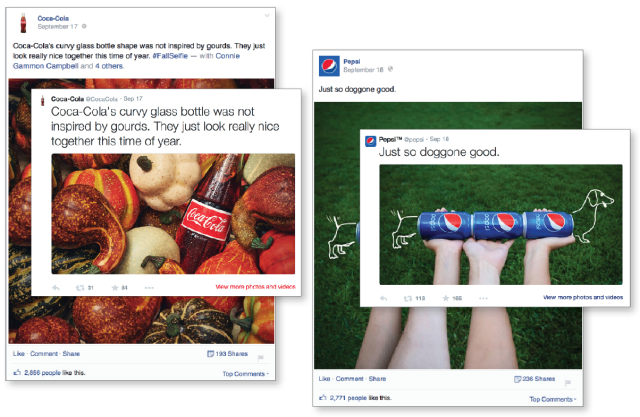The “Pepsi Challenge” was my childhood introduction to one of the most fundamental questions of all time…Coke or Pepsi? The two soda companies have one of the most legendary and long-lasting rivalries in American history. It’s no surprise to see them taking their battle into the social media ring.
Similar product, similar goals
Both Coca-Cola and Pepsi have altered their marketing strategies to include a strong, active social media presence. Both companies are using a variety of platforms to energize communities around their brand.
Both companies appear to have similar goals for their social media efforts:
- Maintain brand image.
- Increase exposure to ad campaigns.
- Increase positive sentiment.
- Drive conversations around the brand.
Coca-Cola seeks to energize the consumer with content
As part of their Content 2020 strategy, Coca-Cola is putting the emphasis on the consumer. They use dynamic storytelling to create fresh content for dissemination. Ashley Callahan, Coke’s Manager of Digital Communications and Social Media, revealed that the company uses a checklist to determine if a piece of content is compelling and captivating enough to draw consumers in:
- Does it answer the “Why should I care” test?
- Does it surprise you?
- Does it have universal appeal?
- Does it generate interest?
- Is content being measured systematically?
Pepsi seeks to add value with small wins
In stark contrast to the Coca-Cola focus on creating dialogue with the consumer, Bonin Bough, Global Director of Digital and Social Media for PepsiCo, states that social media doesn’t need to be a conversation with the consumer. Bonin believes that the biggest social media challenge for businesses is embracing innovation. Bonin believes that social media doesn’t have to follow the rule book for “what works”, but should instead focus on adding value. In an interview with BigThink.com, Bonin said, “The real [Pepsi social media goal] was less about what’s the big strategy? And more about what are the small wins? How do we prove ourselves internally to the organization that these are viable platforms, and then prove successes [within the communities]?”
Who’s winning the social media soda wars?
| Number of followers as reported 9/19/2014* | Pepsi | Coca-Cola |
| 33,345,611 | 88,555,317 | |
| 2.69 million | 2.68 million | |
| Google+ | 1,033,980 | 1,610,721 |
| 1,321 | 4,520 | |
| 45,891 | 308,884 | |
| YouTube | 724,703 | 358,193 |
*Note that each brand also maintains a variety of pages for different products and locations.
The statistics above are from the brand’s main United States page.
It’s interesting that the representation of fan base on social media is not representative of market share.
Clearly, Coca-Cola continues to be dominant company, with their soft drink sales significantly higher than Pepsi (42.4% of market share compared to 27.7% in 2014). According to a fascinating study known as “the Pepsi Paradox”, Coca-Cola has historically been more successful than Pepsi due to brand marketing. In the coming years, it will be interesting to see if Pepsi’s success in social media marketing will help to increase their market share.
In summary
Looking for more on how this rivalry has played on social media? Here are two great comparisons from social media analytics firms:
- Social Bakers in 2012
https://cdn.socialbakers.com/www/archive/storage/www/pepsi-vs-coca-cola.pdf



